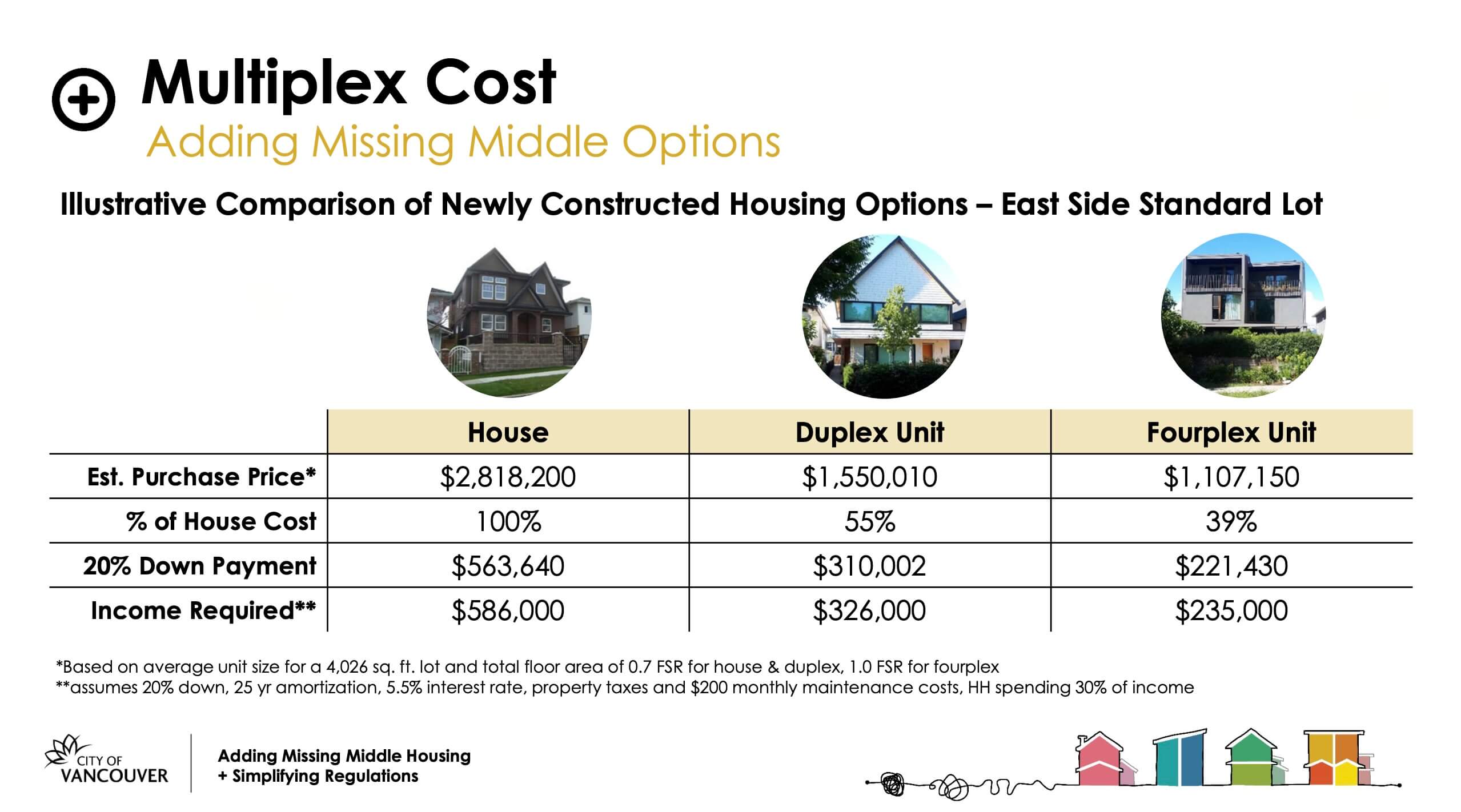
Jul 25, 2023: Council poised to refer Missing Middle Motion to public hearing
When it comes to accelerating housing development, Vancouver City Council has no intention of taking its collective foot off the gas. This coming Tuesday, July 25, the ABC-dominated Council is expected to refer to public hearing a plan that would allow middle income residents in Vancouver the rare chance of becoming homeowners in a city that has become one of the most unaffordable in the world.
If approved, the Adding Missing Middle Housing (MMH) motion could bring major change to all residential neighbourhoods in the city, including Upper Kitsilano, West Point Grey, Fairview, and Mount Pleasant, for example — so-called “low density neighbourhoods” — by allowing multiplexes with three to eight units in addition to laneway houses and duplexes. The idea is to replace expensive detached homes to make room for a growing population. Rental units will be allowed, but the main focus of the plan is on home ownership.
Last month, the majority of respondents to a MMH City survey said they want to see more missing middle housing built in residential neighbourhoods and they want the rules outlining what developers may and may not build to be simplified and clarified. Even though the City declared it a victory for MMH, only 1,895 residents completed the survey. In addition, City staff held at least six workshops with small home builders and designers.
What will be allowed:
The maximum number of units is three to four units on standard 33 ft lots, five units on mid-size lots (40+ ft.), six units on larger lots (50+ ft.) or eight if all units are set aside as secured rental housing.
Other limits and amenities include:Maximum height is 3 storeys and 11.5 m (37.7 ft.).
- Maximum Floor Space Ratio (FSR) is 1.0 FSR.
- Vehicle parking is not required but can be provided at the rear of the lot.
- Bike storage is not required, but a floor area exemption is allowed if provided.
Where can multiplexes be built?
Multiplexes will be allowed in all RS zones, provided that the lot:
- Is located in an RS zone;
- Has a rear lane (or is double-fronting);
- Has a frontage of 10 m (32.8 ft.) or more;
- Is not within a designated floodplain; and
- Is not a legally designated heritage site.
The City staff plan also recommends simplifying a tangle of zoning regulations and amalgamating all RS zones into one. The City currently has nine RS zones — RS-1, RS-1A, RS-1B, RS-2, RS-3, RS-3A, RS-5, RS-6 and RS-7. The new name for the unified zone will be changed to Residential Inclusive zone, R1-1.
What is Middle Missing Housing?
Missing Middle housing refers to dwellings that fall somewhere between a single-family house and a tower. In Vancouver, these forms are deemed to be missing from the housing landscape. In 2021, Cllr. Lisa Dominato brought forward a motion to Council to address the shortage, which was followed up by former mayor Kennedy Stewart’s Making Home plan, which called for six units on a single lot. The current plan takes its cue from both initiatives.
According to City of Vancouver Planning head Theresa O’Donnell, the new MMH proposal is attracting plenty of interest from developers, who helped staff craft the plan. But with run-away mortgage rates and costly building supplies, there is no guarantee how many multiplexes will actually get built.
The MMH proposal has since been updated to include the following additions/changes:
- Construction of these new housing types will require either a set-rate density bonus payment, a below-market homeownership unit, or secured rental housing for the opportunity to access additional density with a multiplex application;
- Extended passive house incentives to multiplexes and simplified passive house regulations;
- Reduced maximum size of new single-detached houses;
Increased maximum size of new laneway houses, and simplified laneway house regulations.
When the plan was first presented to Council, Senior Planner Patricia Huber admitted the work will not happen without side effects. Green space, such as front and back grass yards, and on-site trees and shrubs, will be lost (read Cambie Street). Construction could also lead to damaged root systems of prized 100-year-old boulevard trees. UKRA has other concerns such as the pressure on Vancouver’s aging sewer systems, and an overall reduction in permeability and increase in absorbed heat when yards are removed and covered in concrete. Lack of schools to support the increased population, and increased street parking are also ongoing worries.
The City has very weak heritage and character housing protection, leaving many of Vancouver’s older homes vulnerable to demolition. Those living in existing secondary suites will be displaced — another serious “side effect” of the plan. BC already has the highest rate of no-fault evictions in Canada.
As Andy Yan, director of Simon Fraser University’s City Program said in a Feb. 3, 2023, Globe and Mail story, “As they [the City] go after this new missing middle for home ownership and launch a new wave of building, you will have a displacement effect.” Based on 2021 numbers, Yan estimates that about 50 per cent of households in Kitsilano are renters. “There is already a missing middle that exists in the city of Vancouver that needs to be acknowledged and engaged,” said Prof. Yan.
According to Huber, a tenant protection plan for renters is not included in the plan.
Affordable for whom?
The nagging question of affordability remains unanswered. While the cost of new multiplex units will still be out of reach for many households, the City says the new options will cost less than what is available today. Staff anticipate that a new multiplex unit will be priced at 50 per cent of the cost of a new single-detached house, and about 75 per cent of the cost of a new duplex in a similar location. Consider that the cost to build a detached house on a 33-foot lot in East Vancouver is currently $2.8 million; half a duplex on that same lot would cost $1.55 million, and one-quarter of a four-plex would be $1.1 million, according to City staff. Owning one unit, then, would require an income of $235,000+. (The City has not, to the best of our knowledge, provided estimates of what it would cost to purchase the same type of housing on Vancouver’s Westside).
However, since the introduction of the Broadway and Vancouver Plans, most of us have heard stories from renters and potential homeowners that any government strategy that encourages demolishing older buildings to make way for brand new structures creates higher and higher priced housing. As the demolitions continue, ever more of those in need of housing, including middle-income earners, are shut out.



No Comments